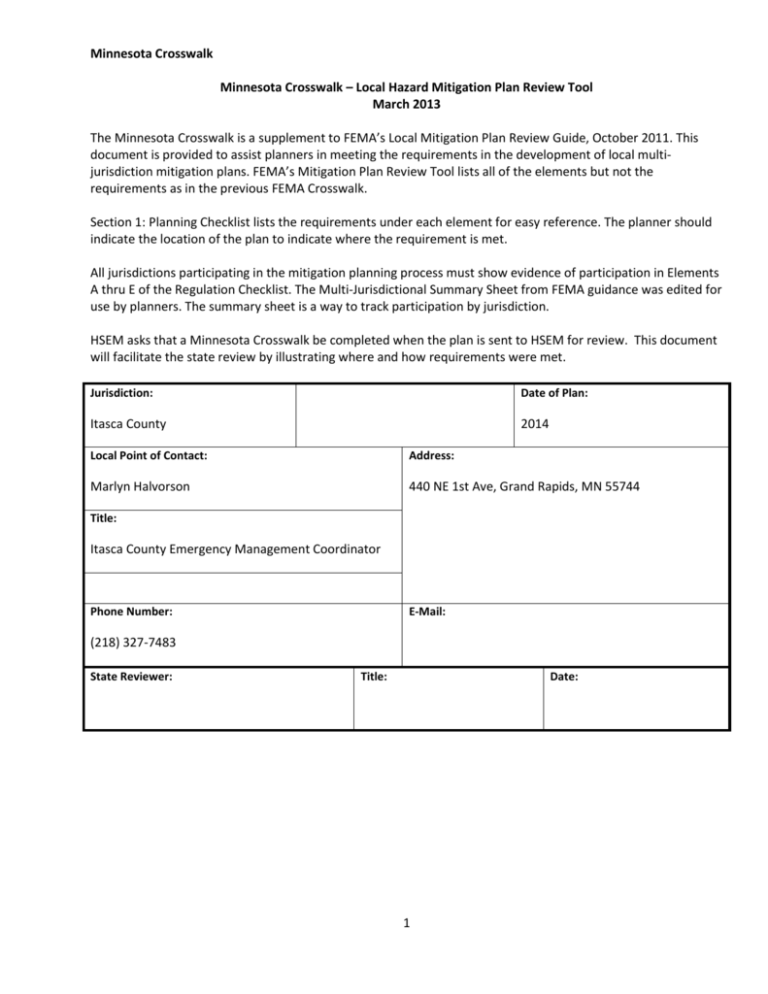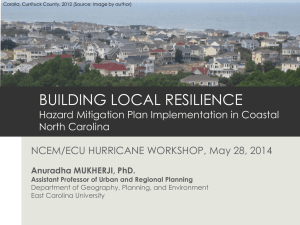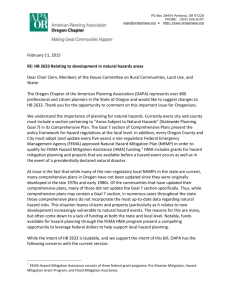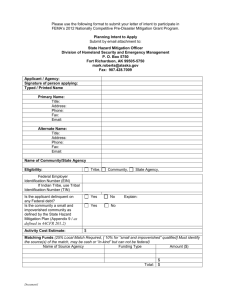MHMP Crosswalk
advertisement

Minnesota Crosswalk Minnesota Crosswalk – Local Hazard Mitigation Plan Review Tool March 2013 The Minnesota Crosswalk is a supplement to FEMA’s Local Mitigation Plan Review Guide, October 2011. This document is provided to assist planners in meeting the requirements in the development of local multijurisdiction mitigation plans. FEMA’s Mitigation Plan Review Tool lists all of the elements but not the requirements as in the previous FEMA Crosswalk. Section 1: Planning Checklist lists the requirements under each element for easy reference. The planner should indicate the location of the plan to indicate where the requirement is met. All jurisdictions participating in the mitigation planning process must show evidence of participation in Elements A thru E of the Regulation Checklist. The Multi-Jurisdictional Summary Sheet from FEMA guidance was edited for use by planners. The summary sheet is a way to track participation by jurisdiction. HSEM asks that a Minnesota Crosswalk be completed when the plan is sent to HSEM for review. This document will facilitate the state review by illustrating where and how requirements were met. Jurisdiction: Date of Plan: Itasca County 2014 Local Point of Contact: Address: Marlyn Halvorson 440 NE 1st Ave, Grand Rapids, MN 55744 Title: Itasca County Emergency Management Coordinator Phone Number: E-Mail: (218) 327-7483 State Reviewer: Title: Date: 1 Minnesota Crosswalk SECTION 1: REGULATION CHECKLIST ELEMENT A. PLANNING PROCESS A1. Does the Plan document the planning process, including how it was prepared and who was involved in the process for each jurisdiction? 44 CFR 201.6(c)(1)) REQUIREMENT LOCATION a. Documentation of how the plan was prepared must include the Section 2.3 Planning Process and Timeline schedule or timeframe and activities that made up the plan’s Steps, Appendix E: Steering Committee development as well as who was involved. Documentation Meetings, Appendix F: Public Meeting typically is met with a narrative description, but may also include, Notices and Meeting Notes for example, other documentation such as copies of meeting minutes, sign‐in sheets, or newspaper articles. b. The plan must list the jurisdiction(s) participating in the plan that seek approval. Section 2.3 Planning Process and Timeline Steps, Section 5.3.1 Hazard Mitigation Actions, Appendix G: Mitigation Actions by Jurisdiction c. The plan must identify who represented each jurisdiction. The Plan must provide, at a minimum, the jurisdiction represented and the person’s position or title and agency within the jurisdiction. Section 2.1 Steering Committee Information d. For each jurisdiction seeking plan approval, the plan must document how they were involved in the planning process. For example, the plan may document meetings attended, data provided, or stakeholder and public involvement activities offered. Jurisdictions that adopt the plan without documenting how they participated in the planning process will not be approved. Section 2.3 Planning Process and Timeline Steps, Section 4.1.2 Vulnerability Assessment by Jurisdiction, Appendix E: Steering Committee Meetings e. Plan updates must include documentation of the current planning process undertaken to update the plan. Section 1.1.1 Scope, Section 2.1 Steering Committee Information, Section 2.2 Review of Existing Plans, Section 2.3 Planning Process Timeline and Steps, Section 4.1.2 Vulnerability Assessment by Jurisdiction, Section 4.1.3 Calculated Priority Risk Index, Section 5 Mitigation Strategy, Appendix E: Steering Committee Meetings, Appendix F: Public Meeting Notices and Meeting Notes, Appendix I: Documentation of Itasca County 2005 Mitigation Actions for 2014 MHMP Update A2. Does the Plan document an opportunity for neighboring communities, local and regional agencies involved in hazard mitigation activities, agencies that have the authority to regulate development as well as other interests to be involved in the planning process? 44 CFR 201.6(b)(2) REQUIREMENT LOCATION a. The plan must identify all stakeholders involved or given an Section 1.1.1 Scope, Section 2.1 Steering opportunity to be involved in the planning process. At a minimum, Committee Information, Appendix E: stakeholders must include: Steering Committee Meetings, Appendix F: 1) Local and regional agencies involved in hazard mitigation Public Meeting Notices and Meeting Notes activities; 2) Agencies that have the authority to regulate development; and 3) Neighboring communities. b. The Plan must provide the agency or organization represented Section 2.1 Steering Committee Information 2 Minnesota Crosswalk and the person’s position or title within the agency. A3. Does the Plan document how the public was involved in the planning process during the drafting stage? 44 CFR 201.6(b)(1) and 201.6(c)(1) REQUIREMENT LOCATION a. The plan must document how the public was given the Section 2.3 Planning Process Timeline and opportunity to be involved in the planning process and how their Steps, Appendix F: Public Meeting Notices feedback was incorporated into the plan. Examples include, but are and Meeting Notes not limited to, sign‐in sheets from open meetings, interactive websites with drafts for public review and comment, questionnaires or surveys, or booths at popular community events. b. The opportunity for participation must occur during the plan Section 2.3 Planning Process Timeline and development, which is prior to the comment period on the final Steps, Appendix F: Public Meeting Notices plan and prior to the plan approval / adoption. and Meeting Notes A4. Does the Plan document the review and incorporation of existing plans, studies, reports, and technical information? 44 CFR 201.6(b)(3) REQUIREMENT LOCATION a. The plan must document what existing plans, studies, reports, Section 2.2 Review of Existing Plans, Section and technical information were reviewed. Examples of the types 4.4 Hazard Profiles (plans identified in each of existing sources reviewed include, but are not limited to, the hazard section) state hazard mitigation plan, local comprehensive plans, hazard specific reports, and flood insurance studies. b. The plan must document how relevant information was Section 2.2 Review of Existing Plans, incorporated into the mitigation plan. 4.4 Hazard Profiles (plans identified and described in each hazard section), Section 5.2 Mitigation Goals A5. Is there discussion on how the community(ies) will continue public participation in the plan maintenance process? 44 CFR 201.6(c)(4)(iii) REQUIREMENT LOCATION a. The plan must describe how the jurisdiction(s) will continue to Section 6.2 Implementation, Section 6.3 seek public participation after the plan has been approved and Continued Public Involvement during the plan’s implementation, monitoring and evaluation. A6. Is there a description of the method and schedule for keeping the plan current (monitoring, evaluating and updating the mitigation plan within a 5‐year cycle)? 44 CFR 201.6I(4)(i) REQUIREMENT LOCATION a. The plan must identify how, when, and by whom the plan will be Section 6.1 Monitoring, Evaluation, and monitored. Updating the Plan b. The plan must identify how, when, and by whom the plan will be evaluated. 3 Section 6.1 Monitoring, Evaluation, and Updating the Plan Minnesota Crosswalk c. The plan must identify how, when, and by whom the plan will be updated. Section 6.1 Monitoring, Evaluation, and Updating the Plan d. The plan must include the title of the individual or name of the department/ agency responsible for leading each of these efforts. Section 6.1 Monitoring, Evaluation, and Updating the Plan ELEMENT B. HAZARD IDENTIFICATION AND RISK ASSESSMENT B1. Does the Plan include a description of the type, location, and extent of all natural hazards that can affect each jurisdiction? 44 CFR 201.6(c)(2)(i) and 44 CFR 201.6(c)(2)(iii) REQUIREMENT LOCATION a. The plan must include a description of the natural hazards that can Section 4.4 Hazard Profiles affect the jurisdiction(s) in the planning area. b. The plan must provide the rationale for the omission of any Section 4.1.2 Vulnerability Assessment by natural hazards that are commonly recognized to affect the Jurisdiction jurisdiction(s) in the planning area. c. The description, or profile, must include information on location, Section 4.4 Hazard Profiles, Appendix C: extent, previous occurrences, and future probability for each Itasca County Hazard Events hazard. Previous occurrences and future probability are addressed in sub‐element B2. d. For participating jurisdictions in a multi-jurisdictional plan, the plan Section 4.4 Hazard Profiles must describe any hazards that are unique and/or varied from those affecting the overall planning area. B2. Does the Plan include information on previous occurrences of hazard events and on the probability of future hazard events for each jurisdiction? 44 CFR 201.6(c)(2)(i) REQUIREMENT LOCATION a. The plan must include the history of previous hazard events for Section 4.1.6 National Climatic Data Center each of the identified hazards. Records, Section 4.1.7 FEMA Declared Disasters, Section 4.4 Hazard Profiles, Appendix C: Itasca County Hazard Events b. The plan must include the probability of future events for each Section 4.4 Hazard Profiles identified hazard. c. Plan updates must include hazard events that have occurred since Section 4.1.6 National Climatic Data Center the last plan was developed. Records, Section 4.1.7 FEMA Declared Disasters, Section 4.4 Hazard Profiles, Appendix C: Itasca County Hazard Events B3. Is there a description of each identified hazard’s impact on the community as well as an overall summary of the community’s vulnerability for each jurisdiction? 44 CFR 201.6(c)(2)(ii) REQUIREMENT LOCATION a. For each participating jurisdiction, the plan must describe the Section 4.1.2 Vulnerability Assessment by potential impacts of each of the identified hazards on the Jurisdiction, Section 4.1.3 Calculated community. Priority Risk Index, Section 4.4 Hazard Profiles b. The plan must provide an overall summary of each jurisdiction’s vulnerability to the identified hazards. The overall summary of vulnerability identifies structures, systems, populations or other community assets as defined by the community that are 4 Section 4.1.2 Vulnerability Assessment by Jurisdiction, Section 4.1.3 Calculated Priority Risk Index, Section 4.4 Hazard Profiles Minnesota Crosswalk susceptible to damage and loss from hazard events. A plan will meet this sub‐element by addressing the requirements described in §201.6(c)(2)(ii)(A‐C). B4. Does the Plan address NFIP insured structures within each jurisdiction that have been repetitively damaged by floods? 44 CFR 201.6(c)(2)(ii) REQUIREMENT LOCATION a. The plan must describe the types (residential, commercial, institutional, etc.) and estimate the numbers of repetitive loss Section 4.4.6 Flash Flood and Riverine properties located in identified flood hazard areas. Flood, Section 5.1.1 National Flood Insurance Program ELEMENT C. MITIGATION STRATEGY C1. Does the plan document each jurisdiction’s existing authorities, policies, programs and resources, and its ability to expand on and improve these existing policies and programs? 44 CFR 201.6(c)(3) REQUIREMENT LOCATION a. The plan must describe each jurisdiction’s existing authorities, Section 4.4 Hazard Profiles – Plans and policies, programs and resources available to accomplish hazard Programs in Place for each hazard, Section mitigation. 5.1 Community Capability Assessment C2. Does the Plan address each jurisdiction’s participation in the NFIP and continued compliance with NFIP requirements, as appropriate? 44 CFR 201.6(c)(3)(ii) REQUIREMENT LOCATION a. The plan must describe each jurisdiction’s participation in the Section 4.4.6 Flash Flood and Riverine NFIP and describe their floodplain management program for Flood, Section 5.1.1 National Flood continued compliance. Simply stating “The community will Insurance Program continue to comply with NFIP,” will not meet this requirement. The description could include, but is not limited to: Adoption and enforcement of floodplain management requirements, including regulating new construction in Special Flood Hazard Areas (SFHAs); Floodplain identification and mapping, including any local requests for map updates; or Description of community assistance and monitoring activities. C3. Does the Plan include goals to reduce/avoid long‐term vulnerabilities to the identified hazards? 44 CFR 201.6I(3)(i) REQUIREMENT LOCATION 5 Minnesota Crosswalk a. The plan must include general hazard mitigation goals that represent what the jurisdiction(s) seeks to accomplish through mitigation plan implementation. Goals are broad policy statements that explain what is to be achieved. b. The goals must be consistent with the hazards identified in the plan. Section 5.2 Mitigation Goals Section 5.2 Mitigation Goals C4. Does the Plan identify and analyze a comprehensive range of specific mitigation actions and projects for each jurisdiction being considered to reduce the effects of hazards, with emphasis on new and existing buildings and infrastructure? 44 CFR 201.6©(3)(ii) and 44 CFR 201.6©(3)(iv) REQUIREMENT LOCATION a. The plan must include a mitigation strategy that 1) analyzes Section 5.3 Mitigation Actions and Projects actions and/or projects that the jurisdiction considered to reduce the impacts of hazards identified in the risk assessment, and 2) identifies the actions and/or projects that the jurisdiction intends to implement. b. Each jurisdiction participating in the plan must have mitigation Section 5.3 Mitigation Actions and Projects, actions specific to that jurisdiction that are based on the Appendix G: Mitigation Actions by community’s risk and vulnerabilities, as well as community Jurisdiction priorities. c. The action plan must reduce risk to existing buildings and Section 5.3 Mitigation Actions and Projects, infrastructure as well as limit any risk to new development and Appendix G: Mitigation Actions by redevelopment. With emphasis on new and existing building and Jurisdiction infrastructure means that the action plan includes a consideration of actions that address the built environment. C5. Does the Plan contain an action plan that describes how the actions identified will be prioritized (including cost benefit review), implemented, and administered by each jurisdiction? 44 CFR 201.6©(3)(iii) and 44 CFR ©(3)(iv) REQUIREMENT LOCATION a. The plan must describe the criteria used for prioritizing Section 5.3 Mitigation Actions and Projects implementation of the actions. b. The plan must demonstrate when prioritizing hazard mitigation Section 5.3 Mitigation Actions and Projects actions that the local jurisdictions considered the benefits that would result from the hazard mitigation actions versus the cost of those actions. The requirement is met as long as the economic considerations are summarized in the plan as part of the community’s analysis. A complete benefic‐cost analysis is not required. Qualitative benefits (for example, quality of life, natural and beneficial values, or other “benefits”) can also be included in how actions will be prioritized. c. The plan must identify the position, office, department, or agency 5.3.1 Hazard Mitigation Actions, Appendix responsible for implementing and administering the action (for G: Mitigation Actions by Jurisdiction each jurisdiction), and identify potential funding sources and expected timeframes for completion. 6 Minnesota Crosswalk C6. Does the Plan describe a process by which local governments will integrate the requirements of the mitigation plan into other planning mechanisms, such as comprehensive or capital improvement plans, when appropriate? 44 CFR 201.6(c)(4)(ii) REQUIREMENT LOCATION a. The plan must describe the community’s process to integrate the Section 5.3 Mitigation Actions and Projects, data, information, and hazard mitigation goals and actions into Section 5.3.1 Hazard Mitigation Actions, other planning mechanisms. 6.2 Implementation, Appendix G: Mitigation Actions by Jurisdiction b. The plan must identify the local planning mechanisms where Section 5.3 Mitigation Actions and Projects, hazard mitigation information and/or actions may be Section 5.3.1 Hazard Mitigation Actions, incorporated. Appendix G: Mitigation Actions by Jurisdiction c. A multi‐jurisdictional plan must describe each participating Section 5.3 Mitigation Actions and Projects, jurisdiction’s individual process for integrating hazard mitigation Section 5.3.1 Hazard Mitigation Actions, actions applicable to their community into other planning Appendix G: Mitigation Actions by mechanisms. Jurisdiction d. The updated plan must explain how the jurisdiction(s) Section 5.3 Mitigation Actions and Projects, incorporated the mitigation plan, when appropriate, into other Section 5.3.1 Hazard Mitigation Actions, planning mechanisms as a demonstration of progress in local Appendix G: Mitigation Actions by hazard mitigation efforts Jurisdiction e. The updated plan must continue to describe how the mitigation Section 5.3 Mitigation Actions and Projects, strategy, including the goals and hazard mitigation actions will be Section 5.3.1 Hazard Mitigation Actions, incorporated into other planning mechanisms. Appendix G: Mitigation Actions by Jurisdiction ELEMENT D. PLAN REVIEW, EVALUATION, AND IMPLMENTATION D1. Was the plan revised to reflect changes in development? 44 CFR 201.6(d)(3) REQUIREMENT LOCATION a. The plan must describe changes in development that have Section 4.3 Future Development, Section occurred in hazard prone areas and increased or decreased the 4.4.3 Summer Storms – Thunderstorms, vulnerability of each jurisdiction since the last plan was approved. Lightning, Hailstorms, and Windstorms If no changes in development impacted the jurisdiction’s overall Vulnerability, Section 4.4.6 Flash Flood and vulnerability, plan updates may validate the information in the Riverine Flood – Vulnerability and Future previously approved plan. Development & Plans and Programs in Place D2. Was the plan revised to reflect progress in local mitigation efforts? 44 CFR 201.6(d)(3) REQUIREMENT LOCATION a. The plan must describe the status of hazard mitigation actions in Section 5.3.1 Hazard Mitigation Actions, the previous plan by identifying those that have been completed Appendix I: Documentation of Itasca County or not completed. For actions that have not been completed, the 2005 Mitigation Actions for 2014 MHMP plan must either describe whether the action is no longer relevant Update or be included as part of the updated action plan. D3. Was the plan revised to reflect changes in priorities? 44 CFR 201.6(d)(3) REQUIREMENT LOCATION a. The plan must describe if and how any priorities changed since Section 2.3 Planning Process Timeline and the plan was previously approved. If no changes in priorities are Steps, Section 4.1.2 Vulnerability necessary, plan updates may validate the information in the Assessment by Jurisdiction, Section 4.1.3 previously approved plan. Calculated Priority Risk Index, Section 5.3 7 Minnesota Crosswalk Mitigation Actions and Projects, Section 5.3.1 Hazard Mitigation Actions ELEMENT E. PLAN ADOPTION E1. Does the Plan include documentation that the plan has been formally adopted by the governing body of the jurisdiction requesting approval? 44 CFR 201.6(c)(5) REQUIREMENT LOCATION a. The plan must include documentation of plan adoption, usually a Haven’t reached this stage yet resolution by the governing body or other authority. In Minnesota, the county passes a formal resolution to adopt the plan. This should takes place immediately after FEMA review to allow the cities time to adopt the plan. E2. For multi‐jurisdictional plans, has each jurisdiction requesting approval of the plan documented formal plan adoption? 44 CFR 201.6(c)(5) REQUIREMENT LOCATION a. Each jurisdiction that is included in the plan must have its Haven’t reached this stage yet governing body adopt the plan prior to FEMA approval, even when a regional agency has the authority to prepare such plans. HSEM recommends that cities adopt the within six months of the county adopting the plan to ensure all adoption requirements are met. 8 Minnesota Crosswalk Section 2 MULTI-JURISDICTIONAL SUMMARY SHEET INSTRUCTIONS: Complete the Multi-jurisdiction Summary Spreadsheet by listing each participating jurisdiction which required Elements for each jurisdiction were ‘Met’ or ‘Not Met’. Adoption resolutions may be tracked after the plan was reviewed by FEMA ‘pending local adoption’. This Summary Sheet does not imply that a miniplan be developed for each jurisdiction; it should be used as an optional worksheet to ensure that each jurisdiction participating in the Plan has been documented and has met the requirements for those Elements (A through E). Requirements Met (Y/N) # Jurisdiction Name 1 Itasca County County Bigfork City Bovey City Calumet City Cohassett City Coleraine City Deer River City Effie City Grand Rapids City Keewatin City La Prairie City Marble City 2 3 4 5 6 7 8 9 10 11 12 Jurisdiction Type (county/city) A. Planning Process B. Hazard Identification & Risk Assessment C. Mitigation Strategy D. Plan Review, Evaluation & Implementation Y Y Y Y After FEMA Approval Y Y Y Y After FEMA Approval Y Y Y Y After FEMA Approval Y Y Y Y After FEMA Approval Y Y Y Y After FEMA Approval Y Y Y Y After FEMA Approval Y Y Y Y After FEMA Approval Y Y Y Y After FEMA Approval Y Y Y Y After FEMA Approval Y Y Y Y After FEMA Approval Y Y Y Y After FEMA Approval Y Y Y Y After FEMA Approval 9 E. Plan Adoption Minnesota Crosswalk 13 14 15 16 17 18 19 20 21 22 23 Nashwauk City Squaw Lake City Taconite City Warba City Zemple City Greenway School Dist. ISD# 316 Deer River School Dist. ISD# 317 Grand Rapids School Dist. ISD# 318 NashwaukKeewatin School Dist. ISD# 319 St. Joseph’s School Northern Lights Communit y School School District Y Y Y Y After FEMA Approval Y Y Y Y After FEMA Approval Y Y Y Y After FEMA Approval Y Y Y Y After FEMA Approval Y Y Y Y After FEMA Approval Y Y Y Y After FEMA Approval Y After FEMA Approval School District Y Y Y School District Y Y Y Y School District School Y Y Y Y Y Y Y Y School Y Y 10 Y Y After FEMA Approval After FEMA Approval After FEMA Approval After FEMA Approval








